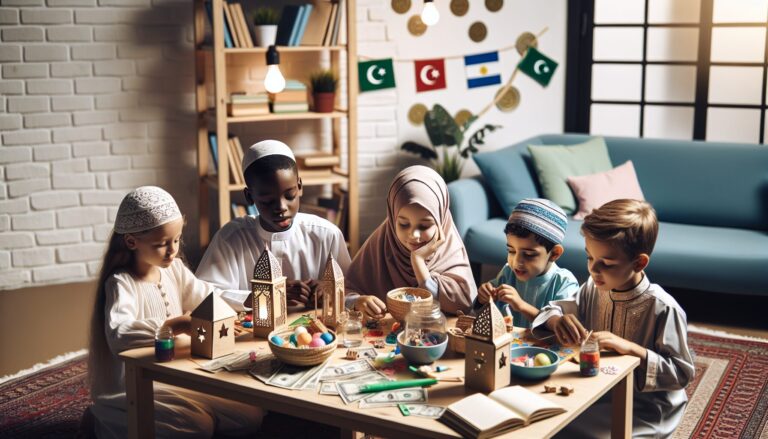I’ll never forget watching a friend’s daughter in Auckland light up last year when she announced she wanted to try her first Ramadan fast – the autumn days were getting shorter but still felt endless to her seven-year-old self! It’s such a special milestone when our little ones express this desire to participate more fully in Ramadan, isn’t it? But as parents, we’re often caught between encouraging their spiritual growth and making sure they’re physically and emotionally ready for this big step. After guiding my own children through their first fasting experiences (where let’s be honest, coordinating suhoor when it’s still pitch dark can be quite the adventure!), I’ve learned that success really comes down to preparation, patience, and making the whole experience feel like the celebration it truly is.
⚠️ Medical Advisory
Children with underlying health conditions, diabetes, or on medication should consult a pediatrician before attempting their first fast. Signs of dehydration, dizziness, or extreme fatigue in fasting children require immediate breaking of the fast and medical attention if symptoms persist.
1. Start with Half-Day Practice Fasts Before Ramadan

Starting your child’s fasting journey with half-day practice fasts is like training wheels on a bike – it builds confidence while keeping things manageable. Many Muslim families in New Zealand have found that beginning these practice sessions during the school holidays in January works perfectly, giving kids time to adjust without the pressure of schoolwork.
The ideal time to begin these practice fasts is about two to three weeks before Ramadan starts. Since you’re heading into autumn when Ramadan arrives, the days are getting shorter, which actually makes it easier for kids. Children aged 7-9 can typically handle fasting from dawn until noon, while those 10-12 might extend until 2 or 3 PM. Remember, every child is different, and what works for a friend’s kids might need tweaking for yours.
Creating a structured approach helps tremendously. Start by choosing weekends for practice fasts when you can monitor your child closely. Wake them for a light pre-dawn meal – think whole grain toast with peanut butter, a banana, and plenty of water. The Ministry of Health recommends that children maintain proper hydration levels, so encourage them to drink at least two glasses of water before beginning their fast.
Making Practice Fasts Engaging and Rewarding
Transform these practice sessions into positive experiences by involving the whole family. If you’re not fasting yourself, consider joining your child for solidarity – it’s amazing how much easier it becomes when Mum or Dad is doing it too! Plan quiet activities for the morning like reading Islamic stories, doing puzzles, or working on a Ramadan craft project together.
Breaking the fast becomes a mini celebration. Set up a special plate with dates, fresh fruit, and their favorite healthy snacks. Many families create a “practice fast chart” where kids can place a star sticker after each successful session. This visual progress tracker builds excitement for their kids’ first Ramadan fast while giving them tangible proof of their achievements.
Watch for signs that indicate when to end the practice fast:
- Excessive fatigue or irritability beyond normal hunger
- Headaches that don’t improve with rest
- Dizziness or difficulty concentrating
- Pale skin color or complaints of feeling cold
The Islamic Council of New Zealand suggests keeping a journal during practice fasts where children can write or draw how they’re feeling. This helps them recognize their body’s signals and gives you insight into their readiness level. Additionally, connecting with other Muslim families in your community provides valuable support and allows kids to share their experiences with peers going through the same journey.
Remember to adjust expectations based on your child’s individual needs. Some kids might need to start with just three or four hours, and that’s perfectly fine. The goal isn’t to push them to their limits but to build positive associations with fasting that will serve them throughout their lives.
2. Create a Special Suhoor Wake-Up Routine with Fun Foods
Making suhoor exciting transforms what could be a groggy, reluctant wake-up into an adventure your little ones actually anticipate. The secret lies in turning this pre-dawn meal into a special family ritual that combines nutrition with genuine fun – something that’ll make your kids’ first Ramadan fast feel less like a challenge and more like a celebration.
Start by creating a “Suhoor Superhero” theme where your children become heroes fueling up for their fasting mission. Set up their plates the night before with colorful sticky notes containing encouraging messages or Islamic reminders. You might write “Today’s fasting champion!” or include a short hadith about the blessings of suhoor. Furthermore, let them choose their own special suhoor cup or plate that only comes out during this blessed month – it’s amazing how something so simple can create excitement around waking up at 4:30 AM!
The food itself needs careful planning to keep your young fasters energized throughout those long autumn days. Complex carbohydrates paired with protein provide the sustained energy release children need, preventing that mid-morning crash that makes fasting harder. Think of these foods like a slow-burning candle rather than a quick flash of fireworks.
Kid-Friendly Suhoor Menu Ideas
Transform ordinary breakfast items into fun, appealing options that’ll have your children actually looking forward to their pre-dawn meal:
- Overnight oats decorated with fruit faces – prepare these before bed using rolled oats, milk, and a touch of honey
- Mini whole grain pancakes shaped into crescents and stars using cookie cutters
- Egg muffins loaded with cheese and vegetables, baked in advance and reheated quickly
- Smoothie bowls topped with granola trails that kids can “design” themselves
- Whole wheat toast soldiers with hummus or peanut butter for dipping
Additionally, consider incorporating traditional foods from your family’s cultural background alongside these kid-friendly options. Many Muslim families have passed down special suhoor recipes through generations, and sharing these creates a beautiful connection to heritage.
Hydration strategy matters enormously for young fasters. The Canterbury District Health Board recommends children drink water steadily throughout suhoor rather than gulping large amounts at once. Make it engaging by adding natural flavors like cucumber slices or frozen berries to their water bottles. You could even create a “hydration station” where kids track their water intake with colorful stickers.
Timing your suhoor routine requires careful balance. Wake your children 45 minutes before fajr prayer, giving them enough time to eat without rushing but not so early that they’re exhausted. Use gentle wake-up methods like soft nasheeds or a sunrise lamp that gradually brightens their room. Some families in Wellington have found success with age-appropriate fasting preparation techniques that include gradually adjusting bedtimes a week before fasting begins.
However, remember that forcing children to eat when they’re not hungry can backfire. If your child struggles with eating so early, start with smaller portions and focus on nutrient-dense foods. A few bites of energy-rich foods work better than a large meal they can’t finish. The Nutrition Foundation suggests prioritizing foods with healthy fats like avocado or nuts, which provide concentrated energy in smaller servings.
Create lasting memories by incorporating special suhoor traditions unique to your family. Maybe it’s sharing what you’re grateful for, reading a short Islamic story, or having each family member make dua for someone special. These moments become the cherished memories your children will carry into their own families one day, making their fasting journey about so much more than just abstaining from food.
3. Plan an Iftar Countdown Activity Chart with Rewards
Creating a visual countdown chart transforms your child’s first fasting experience into an exciting journey filled with anticipation and achievement. You’ll want to grab some colorful poster board, markers, and stickers from your local Warehouse or Kmart to craft something that’ll make your little one’s eyes light up! I’ve found that kids absolutely thrive when they can physically see their progress – it’s like watching their favorite video game level bar fill up.
Start by mapping out the entire month on a large poster, making each day a sizeable square where your child can place stickers or draw pictures after successfully completing their fast. The key is making this chart interactive and personal to your child’s interests – whether they’re into dinosaurs, princesses, or the All Blacks, incorporate these themes into the design. Additionally, consider creating separate sections for partial fasts if your child is gradually building up to full-day fasting.
The reward system needs careful thought to maintain motivation throughout the month. Here’s what works brilliantly:
- Small daily rewards like choosing tomorrow’s iftar dessert or earning 15 extra minutes of screen time
- Weekly milestone prizes such as a trip to Rainbow’s End or a special outing to their favorite halal restaurant
- A grand finale reward for completing their kids first Ramadan fast journey – perhaps that LEGO set they’ve been eyeing at Toyworld
- Non-material rewards like staying up late for special Ramadan programs at the mosque or helping prepare iftar meals
Furthermore, involve your child in creating “iftar countdown cards” for the last hour before breaking fast. These cards can include activities like coloring Islamic patterns, writing what they’re grateful for, or drawing their favorite iftar foods. A friend in Auckland shared that her daughter loves making these while sitting in her sunny garden, watching the clock tick closer to maghrib time.
Making It Educational and Fun
Transform the chart into a learning opportunity by adding daily Islamic facts or stories of the prophets. You could include fun facts about how Muslims celebrate Ramadan in different countries or add Quranic verses with simple explanations. The Federation of Islamic Associations of New Zealand often shares wonderful educational resources that you can incorporate into your chart design.
Consider adding a “feelings tracker” section where children can draw emojis or use color codes to express how they felt during their fast. This helps them develop emotional awareness and gives you insights into when they might need extra support. Therefore, you’re not just tracking fasting success but also building emotional intelligence.
Remember to display the chart prominently – perhaps in the kitchen where the family gathers or near the prayer area. Some families even create a dedicated “Ramadan corner” with the chart as the centerpiece, surrounded by Islamic decorations and books from Darul Kutub or other Islamic bookstores. The visibility keeps the excitement alive and makes every family member part of the journey, turning what could be a challenging experience into a celebrated family tradition that your children will remember fondly for years to come.
Conclusion
In essence, preparing your child for their first Ramadan fast is about creating a balanced approach that combines gradual physical preparation, joyful family traditions, and visual motivation systems that make the journey exciting rather than daunting. By starting with practice fasts, transforming suhoor into a special celebration, and tracking progress with rewarding countdown charts, you’re not just helping your little ones successfully complete their fasts – you’re building beautiful memories and spiritual foundations that will stay with them throughout their lives. May your family’s Ramadan be filled with blessings and joy!
Continue Exploring
Ready to make this Ramadan unforgettable for your little ones? Discover creative crafts, fun learning games, and meaningful activities perfectly designed for preschoolers celebrating in New Zealand. Transform this holy month into a magical experience filled with joy, learning, and precious memories!
Frequently Asked Questions
What age should children start practicing for their first Ramadan fast?
Children aged 7-9 can typically begin with half-day practice fasts from dawn until noon, while those aged 10-12 might extend their fasting until 2 or 3 PM. It’s recommended to start practice sessions about 2-3 weeks before Ramadan begins, ideally during school holidays when you can monitor your child closely. Every child is different, so adjust based on your child’s individual readiness and physical capabilities.
What are the best foods to give children for suhoor during their first Ramadan fast?
The best suhoor foods for children combine complex carbohydrates with protein for sustained energy throughout the day. Great options include overnight oats with fruit, whole grain pancakes, egg muffins with cheese and vegetables, smoothie bowls with granola, and whole wheat toast with hummus or peanut butter. Focus on nutrient-dense foods with healthy fats like avocado or nuts if your child struggles with eating large portions early in the morning.
How can I tell if my child needs to break their fast early?
Watch for warning signs that indicate your child should end their fast: excessive fatigue or irritability beyond normal hunger, headaches that don’t improve with rest, dizziness or difficulty concentrating, and pale skin color or complaints of feeling cold. Keep a journal where children can write or draw how they’re feeling to help them recognize their body’s signals. Remember, the goal isn’t to push children to their limits but to build positive associations with fasting.
Fatima Ansari is an Islamic educator and writer with over a decade of experience teaching Quran and Islamic studies to children and families in Western Muslim communities. Growing up in North America, she saw firsthand the challenges Muslim families face in balancing faith with modern life, which inspired her to share practical guidance rooted in the Quran and Sunnah. Her mission with E-Quran Learning is to make Islamic education accessible, relatable, and inspiring for Muslim families across the United States, United Kingdom, Canada, Australia, and New Zealand.






